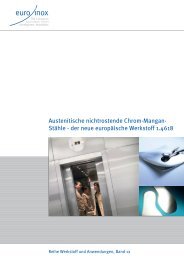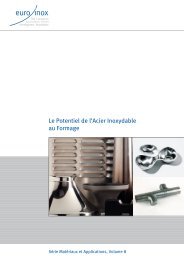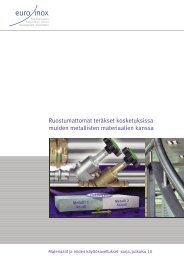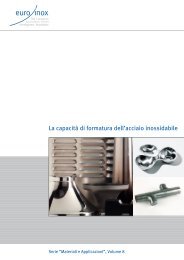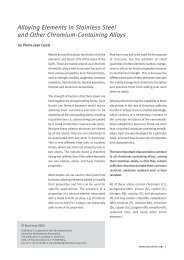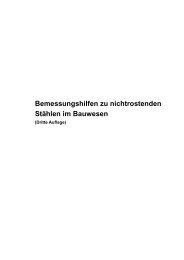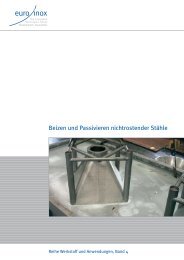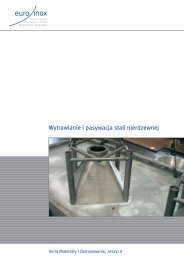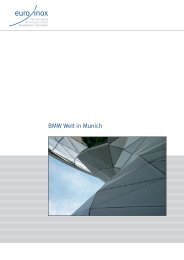Stainless Steel - The Safe Choice - Euro Inox
Stainless Steel - The Safe Choice - Euro Inox
Stainless Steel - The Safe Choice - Euro Inox
Create successful ePaper yourself
Turn your PDF publications into a flip-book with our unique Google optimized e-Paper software.
• Titanium is added to the ferritic grade X2Cr-<br />
MoTi18-2 to prevent intergranular corrosion<br />
which may occur in welded zones. Its<br />
concentration was always less than 5 µg/l.<br />
It improves the pitting corrosion resistance<br />
of this material.<br />
• Nickel concentrations were, in most cases,<br />
less than 2 µg/l. In this context, it should<br />
be noticed that Ni-release was very low<br />
and this result confirms the absence of this<br />
element in the passive film.<br />
Following these results, it can be concluded<br />
that the three stainless steel grades<br />
· X5CrNi18-10/1.4301<br />
(Fe-Cr-Ni austenitic alloy)<br />
· X5CrNi17-12-2/1.4401<br />
(Fe-Cr-Ni-Mo austenitic alloy)<br />
· X2CrTi18-2/1.4521<br />
(Fe-Cr-Mo ferritic alloy)<br />
comply with <strong>Euro</strong>pean regulations on the quality<br />
of water intended for human consumption<br />
(Council Directive 98/83/EC). <strong>The</strong><br />
parametric values reported in the above directive<br />
are :<br />
· 50 µg/l for chromium<br />
· 200 µg/l for iron<br />
· 20 µg/l for nickel<br />
6. Conclusions<br />
<strong>The</strong> wide range of stainless steel applications<br />
brings a large number of consumers into<br />
stainless steel contact be exposed (skin<br />
contact, ingestion of metal ions).<br />
Nickel release from the widely used austenitic<br />
stainless steels (X5CrNi18-10/1.4301 and<br />
X5CrNi17-12-2/1.4401) in prolonged contact<br />
with skin is negligible and no allergic reaction<br />
was seen in already Ni-sensitised persons,<br />
while the lesser used high sulphur grade<br />
(X8CrNiS18-9/1.4305) could elicit reactions.<br />
Release of chromium and nickel from stainless<br />
steel utensils is, in most cases, negligible. It<br />
is clear that the use of stainless steel cooking<br />
utensils does not provide a source of<br />
dietary chromium or nickel of any significance.<br />
<strong>The</strong>re is no advantage to be gained by Ni-sensitised<br />
persons suffering from contact allergy,<br />
in avoiding the use of stainless steel utensils.<br />
As a result of research carried out by international<br />
authorities it is clear that stainless<br />
steel in a material complying with the <strong>Euro</strong>pean<br />
regulations dealing with drinking water.<br />
SAFE STAINLESS STEEL<br />
© <strong>Euro</strong> <strong>Inox</strong> 2002 www.euro-inox.org · 9



